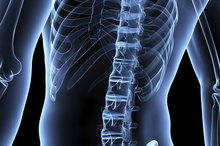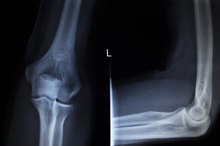Contraindications for Ultrasound Therapy
Therapeutic ultrasound is a modality commonly used by physical therapists. Ultrasound therapy works by driving sound waves into the tissue to help alleviate pain, inflammation and muscles spasms while increasing range of motion. Therapeutic ultrasound can be used to produce both thermal and non-thermal changes in the tissue 2. While this type of ultrasound is safe for treating many conditions, there are contraindications for this therapy 2.
Locations
Use of ultrasound therapy is contraindicated in certain areas of the body, such as over the eyes 2. Due to the poor blood supply in this area, heat caused by sound waves from the ultrasound can build up. This might lead to retinal damage and increased risk for cataracts. Ultrasound therapy applied over the testicles is contraindicated, due to the potential for producing short-term heat-related sterility. Use of ultrasound over the chest of patients with cardiac pacemakers is contraindicated -- sound waves could interfere with the performance of the pacemaker. This type of therapy is also contraindicated over growing bones, as thermal injury can damage growth plates. Due to the tendency of metal to have higher heat conductivity than tissue, ultrasound therapy should never be used directly over metal implants because of the risk for burns.
- Use of ultrasound therapy is contraindicated in certain areas of the body, such as over the eyes 2.
- Ultrasound therapy applied over the testicles is contraindicated, due to the potential for producing short-term heat-related sterility.
Conditions
The Benefits of Magnetic Rings
Learn More
Ultrasound therapy should not be used with certain medical conditions. Application of ultrasound thereapy to cancerous tissue should be avoided 2. Research suggests this could promote metastasis, or spreading of the cancer cells to other parts of the body. Localized tissue or bone infections are contraindicated for treatment with therapeutic ultrasound 2. Heat from the ultrasound therapy increases the likelihood of spreading the infection. Patients with thromboembolic disease, or blood clots, should avoid ultrasound therapy -- heat might increase the risk of a clot dislodging. Therapeutic ultrasound should not be performed over the spine after a laminectomy. Doing so carries risks of injury to the spinal cord.
- Ultrasound therapy should not be used with certain medical conditions.
- Patients with thromboembolic disease, or blood clots, should avoid ultrasound therapy -- heat might increase the risk of a clot dislodging.
Pregnancy
Therapeutic ultrasound should not be applied to the abdomen of pregnant women 2. Unlike diagnostic ultrasound, in which harmless sound waves are used to provide an image of the developing fetus, ultrasound therapy often involves deep penetrating heat and vibration. Ultrasound therapy could overheat the fetus which can possibly lead to a birth defect, especially if administered during the first trimester.
Related Articles
References
- Critical Ultrasound Journal: Overview of Ultrasound Usage Trends in Orthopedic and Sports Physiotherapy
- Journal of Ultrasound in Medicine: Overview of Therapeutic Ultrasound Applications and Safety Considerations
- Jia L, Wang Y, Chen J, Chen W. Efficacy of focused low-intensity pulsed ultrasound therapy for the management of knee osteoarthritis: a randomized, double blind, placebo-controlled trial. Sci Rep. 2016;6:35453. doi: 10.1038/srep35453
- Yeğin T, Altan L, Kasapoğlu Aksoy M. The effect of therapeutic ultrasound on pain and physical function in patients with knee osteoarthritis. Ultrasound Med Biol. 2017;43(1):187-194. doi:10.1016/j.ultrasmedbio.2016.08.035
- Albright J, et al. Philadelphia panel evidence-based clinical practice guidelines on selected rehabilitation interventions for low back pain. Physical Therapy. 2001;81(10):1641-1674. doi:10.1093/ptj/81.10.1641
- Cakir S, Hepguler S, Ozturk C, Korkmaz M, Isleten B, Atamaz FC. Efficacy of therapeutic ultrasound for the management of knee osteoarthritis: a randomized, controlled, and double-blind study. Am J Phys Med Rehabil. 2014;93(5):405-12. doi:10.1097/PHM.0000000000000033








